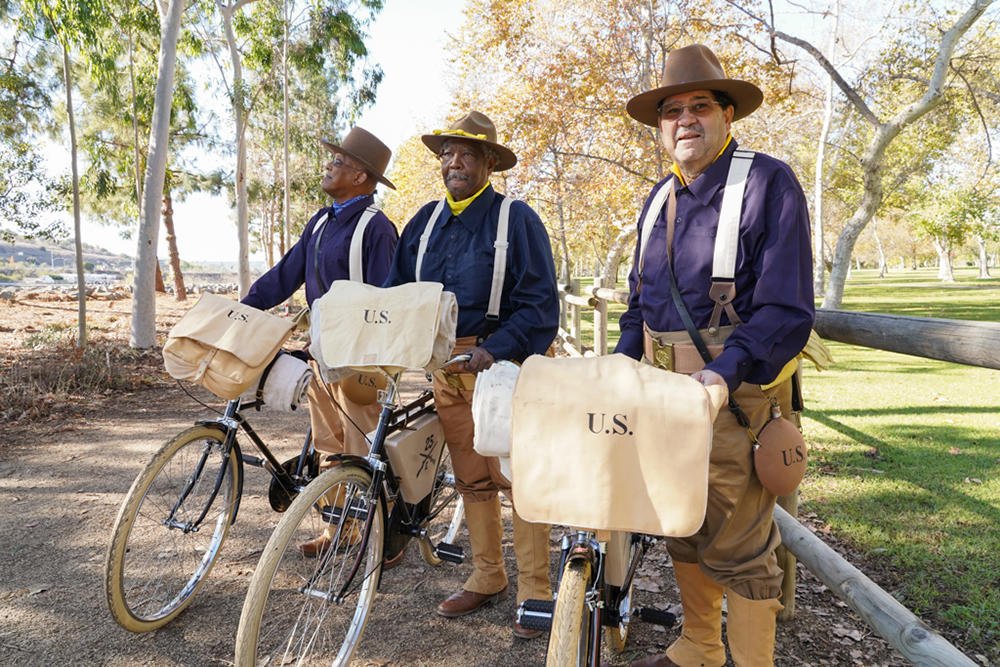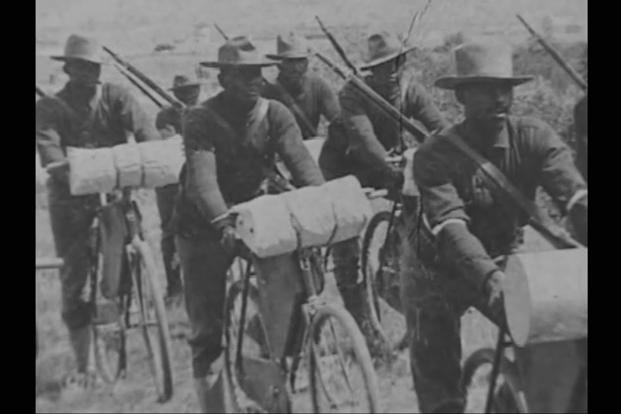
Bobby McDonald’s infectious smile beams as he tells the unusual history of the 20 Black soldiers and their White lieutenant who pioneered the U.S. Army’s use of bicycles.
Military planners’ interest in bicycles likely stemmed from a desire to ditch slow-moving logistics wagons that would stretch for 50-60 miles behind a Civil War-era army. Soldiers had to transport feed for horses, and bicycles could move much more quietly without requiring trips to water troughs.
But the history of bicycles in the service is more than just a technological oddity. It also coincides with a shift in how Black soldiers would serve their country.
Read Next: Navy Secretary Censures 5 Officers over Fatal AAV Sinking
On May 12, 1896, 2nd Lt. James A. Moss received permission to organize the 25th Infantry Bicycle Corps, the first of its kind. Under Moss’ leadership, the initial corps consisted of eight Black enlisted men who learned to ride in formation, drill, ford streams and pedal 40 miles a day.
Now that history is being honored, with McDonald and another Black veteran organizing a ride to commemorate the historical first.
“It was positive history. It’s just positive and educational. You’ve got a bunch of guys who are just trying to do the job,” McDonald told Military.com. “Everyone can rally around bicycles.”
Tuesday marks the 125th anniversary of a test ride Moss and the 25th made, a 1,900-mile, 41- day expedition that began on June 14, 1897, in Missoula, Montana, and ended in St. Louis. It’s also the 247th birthday of the Army itself, placing the historic ride at almost the midpoint in the service’s history.
To honor that ride, reenactors dressed in period uniforms and on replica bicycles will pedal along a portion of the same route forged in 1897. While the majority will ride five miles from the Historical Museum at Fort Missoula to downtown Missoula, adventure cyclist Erick Cedeño is slated to take on the entire route to St. Louis.
The all-Black 25th Infantry Bicycle Corps traveled 1,900 miles from Fort Missoula in Montana to St. Louis in June and July 1897. The journey took 41 days.
The month of events will be spread across three cities: Missoula; Wallace, Idaho; and St. Louis. They will conclude with an event at the Soldiers Memorial Military Museum in St. Louis on July 24 – the date the bicycle corps, nicknamed the Iron Riders, completed their journey.
For more than a year, the event, called Iron Riders 2022, has been planned by a committee that includes Black military veterans. McDonald is the son of a soldier who served with the segregated 1321st Engineer General Service Regiment in Europe and Okinawa during World War I, and is a veteran himself, having volunteered for the Navy on Aug. 11, 1965, the day the Watts Riots started. While deployed on the USS Tripoli in 1967, McDonald served as an aircraft handler, helping launch, land and park UH-1s, CH-47s and HH-53s.
By retelling the story of the Buffalo Soldiers and the 25th Infantry Bicycle Corps, McDonald hopes to bridge divides.
“Our country has gone negative, at least a piece of it,” he said. “I appreciated my time in the service… it didn’t matter who you were and we’ve lost that. Everyone has their own opinion, which is great, but there’s no compromise. We can’t even go along to get along.”
In January, McDonald and another veteran leading the events, Ron Jones, were featured in a short documentary produced by the American Legion. Jones is the son of a World War II veteran and a member of the Army mounted cavalry regiment known as the Buffalo Soldiers.
Jones received his draft notice at 22 years old and had 10 days to report to the Army. Because of the quick turnaround, Jones volunteered for the Navy after an Air Force recruiter said he couldn’t get him inducted before the deadline. Jones was later put on a track as an electrician.
Despite coming into boot camp without knowing how to swim, Jones was recognized early on by drill sergeants as a leader and spent nights in the company commander’s office reading the manual about how to put recruits through boot camp.
He was recruited for the Navy nuclear program, serving as the only Black engineer on any of the three submarines on which he deployed.
“I felt a certain pride in my uniqueness. There was a time in this country when they believed a Black man could never be trained to operate a nuclear reactor,” Jones said in an interview. “I realized if it wasn’t for the Buffalo soldiers, who were the first people of color to serve in the active army. Those men opened the doors for all of us in the military so I could become a nuclear engineer.”
When Jones turned 50 years old, he got into bike riding to mitigate his family history of cardiovascular disease. After riding around his Los Angeles neighborhood for a while, he started signing up for 100-mile rides.
“People ride bicycles all the time, but who rides 1,900 miles across the country? I wanted to start telling their story,” Jones said.
In 2010, he saw a photo of Buffalo Soldiers on bicycles for the first time.
By driving his father to meetings of the local chapter of the 9th and 10th Cavalry (Horse) Association, Jones got involved in telling the stories of Black service members who served in segregated units from the late 19th century to the mid-20th century.
“That was definitely something we could relate to each other about,” he says.

African American military history experienced a revival in the 1970s amid movies that featured the Buffalo Soldiers, The public’s interest was further captured by the 1989 film “Glory” on the 54th Massachusetts Volunteer Infantry, said Tate Jones, director of the Rocky Mountain Museum of Military History at Fort Missoula. Since joining the museum, Jones said interest in the story of Black troops on bicycles has increased, which he attributes to renewed attention on Black military history.
During the late 19th century, the bicycle’s increasing popularity caught the attention of the U.S. military. In 1892, Maj. Gen. Nelson A. Miles, as commander-in-chief of the Army, recommended one full regiment be equipped with bicycles, and that existing troops at posts throughout the country use bicycles for transportation.
“This was an interlude for the Army. By 1897, the Indian Wars had been over for a significant period of time. We weren’t really involved in the imperial era yet in Cuba and the Philippines. There was kind of a lull that allowed some people in the Army to experiment,” Jones said.
The 1,900-mile ride to St. Louis by the 25th wasn’t that unit’s first test. A little less than a year before, they rode from Missoula to Yellowstone National Park and back, an 800-mile journey they covered on Spalding bicycles – each packed with a rifle, 50 rounds of ammunition, knapsack, blanket roll, a shelter and drinking cup.
The history of the much longer ride in 1897 largely survives through newspaper clippings. The soldiers endured thirst, hunger, cold, heat and loss of sleep, according to press coverage of the expedition.
Despite these and other hardships, the 25th Bicycle Corps was greeted upon its arrival in St. Louis on July 24, 1897. They returned to Fort Missoula by train. The Army denied Moss’ request for additional cross country bicycle tests, and the experiment was overtaken by plans for a war with Spain.
In 1898, the 25th Infantry Regiment left Fort Missoula for Cuba to fight in the Spanish-American War.
“It was the greatest experiment the Army ever had on a bicycle,” McDonald said. I keep telling people I don’t have to clean it. I don’t have to clean up behind it. I don’t have to feed it. I don’t have to worry about it throwing me off.”
Related: How a Race Riot Involving an Army Unit Led to the Largest Murder Trial in US History
© Copyright 2022 Military.com. All rights reserved. This material may not be published, broadcast, rewritten or redistributed.
